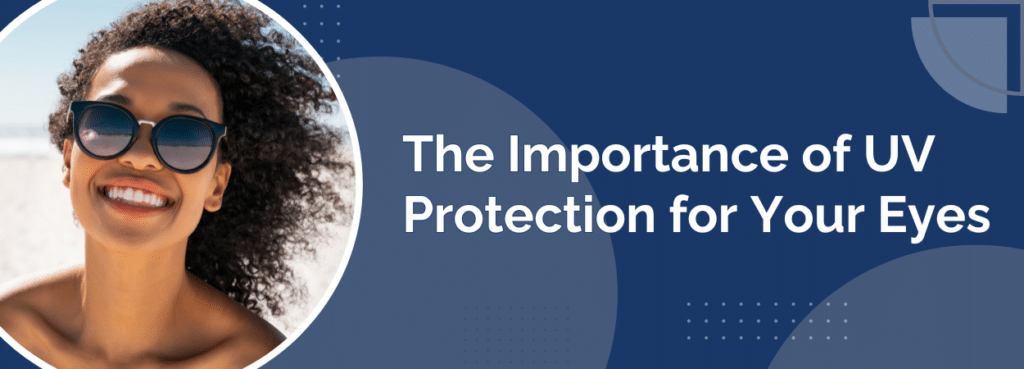
July is UV Safety Month, which makes it the perfect time learn how to protect your eyes from UV exposure. While the sun is the most obvious source of UV rays, hidden sources such as reflective surfaces, artificial sources, high altitudes, and overcast days also pose risks to your eye health. By understanding these hidden sources and taking proactive steps to protect your eyes, you can maintain healthy vision and reduce the risk of UV-related eye diseases.
Hidden Sources of UV Rays
- Reflective Surfaces
- Water: Water reflects UV rays, increasing exposure when you’re at the beach, pool, or lake. Even if you’re not directly in the sun, your eyes can still be affected.
- Snow: Snow reflects up to 80% of UV rays, making winter sports a significant risk for UV exposure. Wearing UV-protective goggles or sunglasses is crucial in snowy conditions.
- Sand and Concrete: These surfaces can reflect UV rays back into your eyes, leading to increased exposure. Always protect your eyes when spending time on the beach or in urban environments.
- Artificial Sources of UV Rays
- Tanning Beds: Tanning beds emit UV radiation that can be harmful to your eyes. Protective goggles designed for tanning beds are essential to shield your eyes.
- Welding Equipment: Welding produces intense UV radiation, which can cause serious eye injuries. Proper helmets with UV filters are necessary for protection.
- Certain Types of Lighting: Some fluorescent and halogen lights emit low levels of UV radiation. While the risk is minimal, it’s still wise to limit prolonged exposure.
- High Altitudes
- UV exposure increases with altitude. When you’re hiking or skiing in the mountains, the thinner atmosphere allows more UV rays to reach your eyes. UV-protective eyewear is essential in these environments.
- UV exposure increases with altitude. When you’re hiking or skiing in the mountains, the thinner atmosphere allows more UV rays to reach your eyes. UV-protective eyewear is essential in these environments.
- Overcast Days
- Up to 80% of UV rays can penetrate through clouds. Even on cloudy days, it’s important to wear sunglasses to protect your eyes.
Eye Diseases Resulting from lack of UV Protection
We see and treat a variety of eye conditions at Sweeney Eye Associates. Common eye conditions caused from UV exposure (among other things) include:
- Cataracts: UV exposure can increase the risk of developing cataracts, a condition where the lens of the eye becomes cloudy, leading to vision impairment. Learn More | Self-Test
- Macular Degeneration: rays can damage the macula, the part of the retina responsible for central vision, leading to macular degeneration. This condition can result in significant vision loss over time. Watch Video
- Pterygium: Also known as “surfer’s eye,” pterygium is a growth on the white part of the eye that can extend over the cornea and affect vision. UV exposure is a major risk factor for this condition. Watch video
- Photokeratitis: Often referred to as “snow blindness,” photokeratitis is a painful condition caused by intense UV exposure, leading to temporary loss of vision. This can be diagnosed through an eye exam.
Tips for Keeping Your Eyes Safe from UV Rays
1. Wear UV-Protective Sunglasses
- Look for UV400 or 100% UV Protection Labels: Ensure your sunglasses block 100% of both UVA and UVB rays. Sunglasses labeled “UV400” offer this level of protection.
- Wrap-Around Styles: Opt for wrap-around sunglasses to protect your eyes from UV rays entering from the sides.
- Polarized Lenses: While polarization doesn’t provide UV protection, it can reduce glare from reflective surfaces like water, snow, and pavement, making your vision more comfortable.
- Check Lens Quality: Ensure the lenses are free from distortions and imperfections. Even inexpensive sunglasses can provide adequate UV protection if they meet these criteria.
- Tint and Darkness: The tint of the lenses doesn’t correlate with UV protection. Choose the tint that suits your comfort without assuming darker lenses offer more protection.
2. Use Hats and Seek Shade
- Wide-Brimmed Hats: Wearing a hat with a wide brim can block up to 50% of UV radiation and provide additional protection for your eyes and face.
- Seek Shade: Whenever possible, stay in the shade, especially during peak sunlight hours (10 a.m. to 4 p.m.), when UV radiation is strongest.
3. Be Mindful of Reflective Surfaces
- Water, Snow, Sand, and Concrete: These surfaces can reflect UV rays, increasing your exposure. Wear UV-protective sunglasses even if you’re not directly in the sun.
4. Protect Your Eyes During Outdoor Activities
- Sports and Outdoor Work: Use sports-specific UV-protective eyewear when engaging in activities such as skiing, snowboarding, fishing, or working outdoors.
- Tanning Beds: Always wear protective goggles designed for tanning beds to shield your eyes from UV radiation.
5. Regular Eye Exams
- Monitor Eye Health: Regular eye exams are essential for detecting any UV-related damage early. Your ophthalmologist can provide personalized advice on UV protection based on your lifestyle and activities.
- Early Detection: Early detection of UV-related eye diseases, such as cataracts, macular degeneration, and pterygium, can lead to more effective treatment and better outcomes.
Q&A
Q: If I never wore sunglasses, is it too late to protect my eyes now?
A: No, it’s never too late to start protecting your eyes from UV radiation.
According to the American Academy of Ophthalmology, starting to protect your eyes now can still prevent further damage and reduce the risk of developing UV-related eye diseases in the future. Wearing UV-protective sunglasses, hats, and seeking shade are effective measures to protect your eyes at any age. Regular eye exams are also important for monitoring your eye health and catching any early signs of damage.
Need an Appointment?
Sweeney Eye Associates offers treatment for all eye conditions regardless of the cause. We also offer exams for those with healthy eyes to ensure lifelong eye health. Get in touch today!





